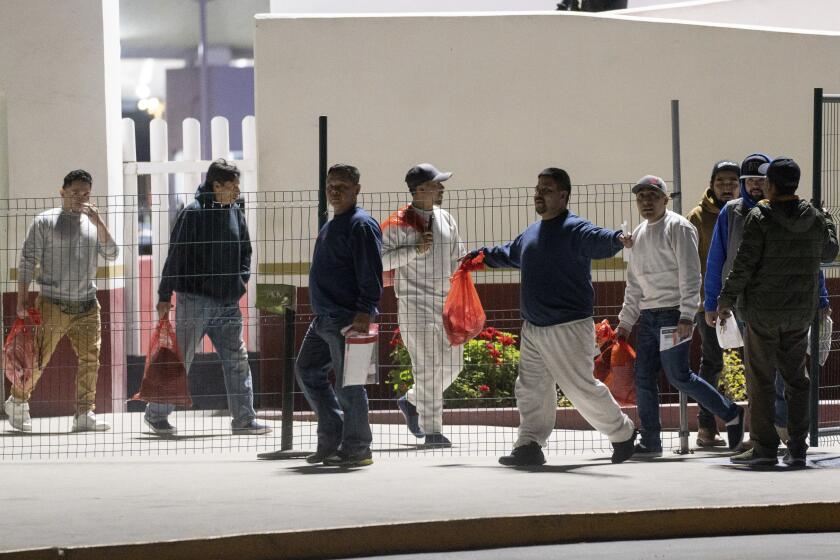International students create an app to prevent food waste
- Share via
SAN DIEGO — Till Hartwig , 24, and Till Kuehn, 23, have more than just a home country and a first name in common.
The two were both students at Germany’s Berlin School of Economics and Law when they applied for an exchange semester at San Diego State University. The men, who met during the application process, were both accepted into the program in the fall of 2019.
The two immediately bonded over their shared passion for business and entrepreneurship. In fact, it was during an entrepreneurship class taught by Tanya Hertz that the two began discussing business ideas. Hertz was the one who encouraged them to enter a pitch contest put on by the SDSU Zip Launchpad program, which is designed to help students launch start-ups from idea to inception.
The two pitched their idea, an app called, fittingly, Till the App, which lets restaurants sell unsold food at the end of the day for major discounts. This limits the amount of food that is normally thrown away at the end of the night, and it also helps people who might not be able to afford to eat out at normal prices.
“We both worked in the restaurant industry during high school and also during our studies to earn some money,” said Hartwig during a phone call. “So we saw firsthand the alarming amount of food being wasted.”
At the end of January 2021, the app was officially launched with the help of Zip Launchpad and the Regional Entrepreneurship Center, or the REC Innovation Lab, at Miramar College.
Here’s how the app works: When a restaurant realizes it will have extra, unsold food at the end of a shift, it can upload that information to the app.
“They can upload the food in just a few steps, it really takes a few seconds for them,” Hartwig said. “And it’s online and people who are looking for deals in the area can see the food. The idea is that the restaurants, since they would lose money on this food anyway, give a big discount, so this helps the restaurant to make some money off the food and not to throw it away.”
The app has been successful with restaurants and customers. At this time, it is being marketed mostly to college students who might not have the budget to eat out on a regular basis. A few local participating restaurants include Ambrogio15 in Pacific Beach, Donut Bar in Pacific Beach, Flavors of East Africa in North Park, Arslans Gyros in Pacific Beach and others.
Hartwig and Kuehn consider the app an all-around win for all involved: the restaurants, which can sell food that would otherwise go unsold; and the consumer, who can get discounted meals; and the environment, because the app cuts down on waste.
The journey to bring the app to life was not without its challenges. At the time that the duo came up with the idea, they were here as part of an exchange program. They asked their school for help with staying in San Diego longer, but the program was designed for only a semester. So they decided to re-enroll at SDSU as international students, which cost them full tuition to continue studying during the spring 2020 semester.
“We have overcome a lot of obstacles, but for us, we’re problem-solvers. We see a problem and we want to solve it. We’re super confident that everything that comes in our way, we’ll be able to do the best,” Hartwig said.
Rose Wong is the owner of Donut Bar in Pacific Beach. She says she was approached by Kuehn and Hartwig about the app in 2020.
“They were just beginning to sign on restaurants,” she said. “They were visiting PB and saw our shop, so they came in and talked to me about what their plans were for the app. I really thought it was a great idea, a great concept, to save waste and help restaurants sell the last of their items or food before they close. I though it was a great concept. They were really young entrepreneurs, I’m a young entrepreneur, so I wanted to support them.”
Wong says the process of listing food is simple. Restaurants can go on the app and list the type and quantity of food available for purchase at a discount. They then choose a time frame for when customers can come pick up.
“I find it easy to use. It’s a really pretty app, too. It’s very self-explanatory,” Wong said.
Because the app is still in its infancy, Wong says the response from the public has been up and down, but she feels that with more public awareness, its popularity will continue to climb.
“Because the app is so new, it’s just waiting for more exposure,” she said.
Currently, the Till app has eight team members and four interns, mostly college students and alumni from SDSU, the University of San Diego and San Diego Miramar College. Financing comes from various sources, including the Zip Launchpad’s Aztec Cooperative Fund, the Lavin Early Seed Startup Fund, the Zahn Success Fund Award and the REC Innovation Lab at Miramar College.
As for the future of the app, Hartwig says the goal is to have as much of a positive effect as possible.
“We definitely do this mainly for the social impact, so we want to scale this app as big as possible,” he said. “Obviously, we’re going to start in San Diego, but in the end, we want to make this as big as possible, and if we can make it worldwide, we’re going to do it worldwide.”
Kuehn added that another goal would be to implement a donation feature on the app, so that meals could be donated as well as purchased.
For more information about the app, visit tilltheapp.com.
Ianni writes for the San Diego Union-Tribune.
More to Read
Sign up for Essential California
The most important California stories and recommendations in your inbox every morning.
You may occasionally receive promotional content from the Los Angeles Times.











